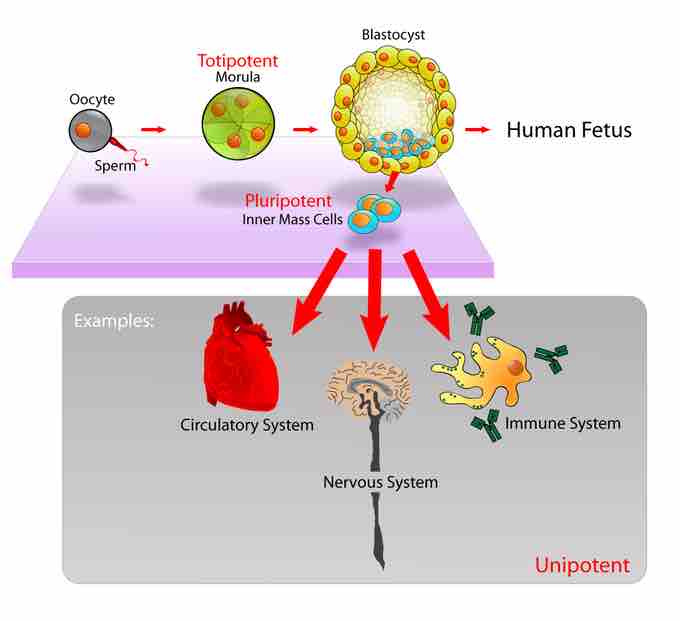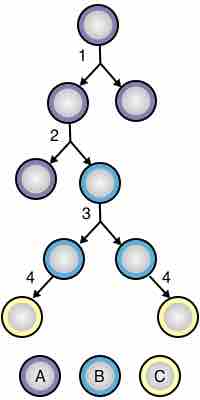Adding cells through cellular division
Stem cells are undifferentiated biological cells found in multicellular organisms, that can differentiate into specialized cells (asymmetric division) or can divide to produce more stem cells (symmetric division). In mammals, there are two broad types of stem cells: embryonic stem cells, which are isolated from the inner cell mass of blastocysts, and adult stem cells, which are found in various tissues. In adult organisms, stem cells and progenitor cells act as a repair system for the body by replenishing adult tissues. In a developing embryo, stem cells can differentiate into all of the specialized cells (including ectoderm, endoderm and mesoderm cells) but also maintain the normal turnover of regenerative organs, such as blood, skin, or intestinal tissues . The pathway that is taken to produced specialized cells included: the embryonic cells develop from totipotent cells, to pluripotent cells which undergo differentiation and become more specialized. The key component however, in the ability to maintain tissues is the ability to maintain a key of stem cells.

Stem Cells
Pluripotent, embryonic stem cells originate as inner cell mass (ICM) cells within a blastocyst. These stem cells can become any tissue in the body, excluding a placenta. Only cells from an earlier stage of the embryo, known as the morula, are totipotent, able to become all tissues in the body and the extraembryonic placenta.
There are three accessible sources of autologous adult stem cells in humans: (1) bone marrow, which requires extraction by harvesting (i.e., drilling into bone); (2) adipose tissue (lipid cells), which requires extraction by liposuction; and (3) blood, which requires extraction through apheresis (wherein blood is drawn from the donor, passed through a machine that extracts the stem cells, and returned to the donor). Stem cells can also be taken from umbilical cord blood just after birth. Of all the stem cell types, autologous harvesting involves the least risk. By definition, autologous cells are obtained from one's own body, just as one may bank his or her own blood for elective surgical procedures. Highly plastic adult stem cells are routinely used in medical therapies, for example in bone marrow transplantation. Stem cells can now be artificially grown and differentiated into specialized cell types with characteristics consistent with muscle or nerve cells through cell culture. Embryonic cell lines and autologous embryonic stem cells generated through therapeutic cloning have also been proposed as promising candidates for future therapies.
Symmetric and asymmetric cell division
To ensure self-renewal, stem cells undergo two types of cell division: symmetric and asymmetric. Symmetric division gives rise to two identical daughter cells both endowed with stem cell properties. Asymmetric division, on the other hand, produces only one stem cell and a progenitor cell with limited self-renewal potential. Progenitors can go through several rounds of cell division themselves before terminally differentiating into a mature cell. . It is possible that the molecular distinction between symmetric and asymmetric division lies in differential segregation of cell membrane proteins between the daughter cells. An alternative theory is that stem cells remain undifferentiated due to environmental cues in their particular niche. Stem cells differentiate when they leave that niche or no longer receive those signals.

Symmetric and Asymmetric Division
This diagram illustrates stem cell division and differentiation, through the processes of (1) symmetric stem cell division, (2) asymmetric stem cell division, (3) progenitor division, and (4) terminal differentiation. Stem cells are indicated by (A), progenitor cells by (B), and differentiated cells by (C).
An asymmetric cell division produces two daughter cells with different cellular fates. This is in contrast to normal symmetric cell divisions, which give rise to daughter cells of equivalent fates. Notably, stem cells divide asymmetrically to give rise to two distinct daughter cells: one copy of the original stem cell as well as a second daughter programmed to differentiate into a non-stem cell fate.
In principle, there are two mechanisms by which distinct properties may be conferred on the daughters of a dividing cell. In one, the daughter cells are initially equivalent but a difference is induced by signaling between the cells, from surrounding cells, or from the precursor cell. This mechanism is known as extrinsic asymmetric cell division. Extrinsic factors involve interactions with neighboring cells and the micro and macro environment of the precursor cell.
In the second mechanism, the prospective daughter cells are inherently different at the time of division of the mother cell. Because this latter mechanism does not depend on interactions of cells with each other or with their environment, it must rely on intrinsic asymmetry. The term asymmetric cell division usually refers to such intrinsic asymmetric divisions. Intrinsic factors generally involve differing amounts of cell-fate determinants being distributed into each daughter cell.
Animals are made up of a vast number of distinct cell types. During development, the zygote undergoes many cell divisions that give rise to various cell types, including embryonic stem cells. Asymmetric divisions of these embryonic cells gives rise to one cell of the same potency (self-renewal), and another that may be of the same potency or stimulated to further differentiate into specialized cell types such as neurons. Asymmetric division of stem cells plays a key role in development by allowing for the differentiation of a subset of daughter cells while maintaining stem cell pluripotency. Since it can be controlled by both intrinsic and extrinsic factors, upon delineating these particular factors it may be possible to use this knowledge in applications of tissue and whole organ generation.